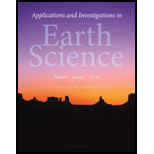
The name of the physical property that corresponds to each of the given statement.
Introduction:
The minerals exhibit various physical properties which play a very important role in their identification. Some of the physical properties remain specific for a particular class of minerals, whereas some of the properties tend to change within the different specimens belonging to the same group of minerals.
Explanation of Solution
• Breaks along smooth planes:
This physical property exhibited by minerals is known as cleavage. The breakage occurs when one mineral gets stuck with another mineral.
• Scratches glass:
This physical property exhibited by minerals is known as hardness. It is the ability to resist scratching.
• Shines like a metal:
This physical property exhibited by minerals is known as luster.
• Scratching produces a red powder:
This physical property exhibited by minerals is known as a streak. Streak is basically the powdered form of the actual color of the mineral.
• Looks like broken glass:
This physical property exhibited by minerals is known as a fracture. The mineral looks like a broken glass only when it is fractured in an irregular pattern.
Want to see more full solutions like this?
Chapter 1 Solutions
Applications and Investigations in Earth Science (8th Edition)
- 45) The roughness layer refers to A) the atmospheric layer where wind has the fastest velocities. B) the layer of active weather between the stratosphere and the surface. C) the shallow layer of nearly still air. D) the layer of the atmosphere where dust storms occur.arrow_forward47) Deflation is the process by which A) wind transports smaller particles leaving behind only larger pebbles and rocks. B) sands are deposited closer to the source area and silts are deposited farther. C) sand dunes migrate downwind as sand saltates up the windward face. D) rocks are worn away by bombardment of particles carried in Windstream.arrow_forward46) In Barchan dunes, the slip face is oriented A) on the convex side of the dunes. B) parallel to wind direction. C) on the concave side of the dunes. D) at varying angles.arrow_forward
- 43) Glacial abrasion is when A) boulders are fragmented into smaller particles under the weight of the overlying ice. B) blocks of rocks are plucked from the underlying bedrock. C) rocks are carried at the base of a glacier and grind away at the underlying bedrock. D) debris fall onto the top of the glacier and are carried down glacier.arrow_forward34) Which of the following is true of soils? A) Soils rich in mineral matter are usually dark in colour. B) They usually require hours or days to form. C) Their development is affected by climate and organisms. D) Their properties are not affected by the type of rock from which they form. E) Older soils usually have fewer horizons than younger soils.arrow_forward44) In periglacial environments, the layer of ground that thaws every summer and freezes every winter is called A) frost layer B) permafrost C) active layer D) discontinuous permafrostarrow_forward
- 42) The ablation zone of a glacier A) has a total positive mass balance. B) is where snow accumulates and transforms into ice. C) is located in the upper part of the glacier. D) is where ice mass is lost.arrow_forward41) Alpine glaciers A) are the largest types of glaciers. B) conform to the shape of the landscape. C) cover large sections of continents. D) show no relationship with the underlying topography.arrow_forward40) Marine terraces are the result of A) coastal emergence through uplift or sea level decrease. B) coastal submergence through erosion or sea level increase. C) deposition of sands by the longshore current. D) wave refraction causing a loss of energy that allow sediments to be deposited.arrow_forward
- 39) Translatory waves A) are the types of waves located furthest away from the shore. B) are slowed down by friction with the bottom of the ocean. C) move water particles in perfectly circular orbits. D) do not interact with the bottom of the ocean.arrow_forward37) Which of the following terms is used for a type of sediment transport in streams? A) discharge. B) overland flow. C) saltation. D) sheet flow. E) abrasion.arrow_forward33) You would expect only slight physical and chemical weathering under conditions of A) temperatures below freezing. B) extreme cold and high precipitation. C) extreme heat and no precipitation. D) lower mean annual rainfall and temperatures. E) higher temperatures and lower precipitation.arrow_forward
 Applications and Investigations in Earth Science ...Earth ScienceISBN:9780134746241Author:Edward J. Tarbuck, Frederick K. Lutgens, Dennis G. TasaPublisher:PEARSON
Applications and Investigations in Earth Science ...Earth ScienceISBN:9780134746241Author:Edward J. Tarbuck, Frederick K. Lutgens, Dennis G. TasaPublisher:PEARSON Exercises for Weather & Climate (9th Edition)Earth ScienceISBN:9780134041360Author:Greg CarbonePublisher:PEARSON
Exercises for Weather & Climate (9th Edition)Earth ScienceISBN:9780134041360Author:Greg CarbonePublisher:PEARSON Environmental ScienceEarth ScienceISBN:9781260153125Author:William P Cunningham Prof., Mary Ann Cunningham ProfessorPublisher:McGraw-Hill Education
Environmental ScienceEarth ScienceISBN:9781260153125Author:William P Cunningham Prof., Mary Ann Cunningham ProfessorPublisher:McGraw-Hill Education Earth Science (15th Edition)Earth ScienceISBN:9780134543536Author:Edward J. Tarbuck, Frederick K. Lutgens, Dennis G. TasaPublisher:PEARSON
Earth Science (15th Edition)Earth ScienceISBN:9780134543536Author:Edward J. Tarbuck, Frederick K. Lutgens, Dennis G. TasaPublisher:PEARSON Environmental Science (MindTap Course List)Earth ScienceISBN:9781337569613Author:G. Tyler Miller, Scott SpoolmanPublisher:Cengage Learning
Environmental Science (MindTap Course List)Earth ScienceISBN:9781337569613Author:G. Tyler Miller, Scott SpoolmanPublisher:Cengage Learning Physical GeologyEarth ScienceISBN:9781259916823Author:Plummer, Charles C., CARLSON, Diane H., Hammersley, LisaPublisher:Mcgraw-hill Education,
Physical GeologyEarth ScienceISBN:9781259916823Author:Plummer, Charles C., CARLSON, Diane H., Hammersley, LisaPublisher:Mcgraw-hill Education,





